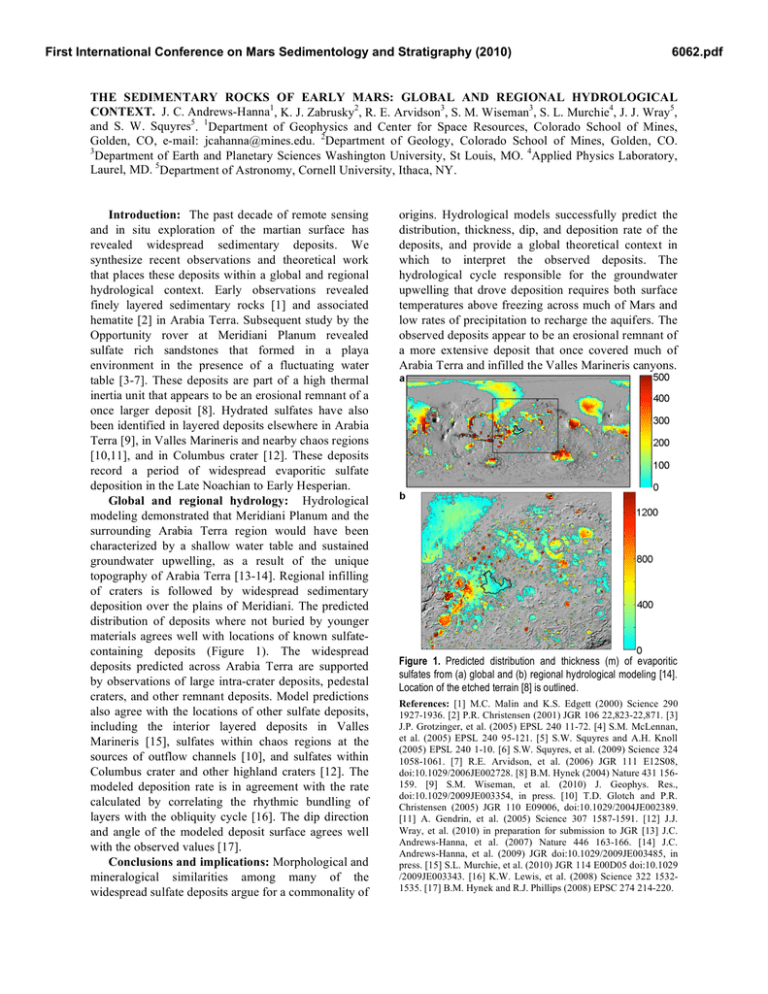THE SEDIMENTARY ROCKS OF EARLY MARS: GLOBAL AND REGIONAL HYDROLOGICAL CONTEXT.
advertisement

First International Conference on Mars Sedimentology and Stratigraphy (2010) 6062.pdf THE SEDIMENTARY ROCKS OF EARLY MARS: GLOBAL AND REGIONAL HYDROLOGICAL CONTEXT. J. C. Andrews-Hanna1, K. J. Zabrusky2, R. E. Arvidson3, S. M. Wiseman3, S. L. Murchie4, J. J. Wray5, and S. W. Squyres5. 1Department of Geophysics and Center for Space Resources, Colorado School of Mines, Golden, CO, e-mail: jcahanna@mines.edu. 2Department of Geology, Colorado School of Mines, Golden, CO. 3 Department of Earth and Planetary Sciences Washington University, St Louis, MO. 4Applied Physics Laboratory, Laurel, MD. 5Department of Astronomy, Cornell University, Ithaca, NY. Introduction: The past decade of remote sensing and in situ exploration of the martian surface has revealed widespread sedimentary deposits. We synthesize recent observations and theoretical work that places these deposits within a global and regional hydrological context. Early observations revealed finely layered sedimentary rocks [1] and associated hematite [2] in Arabia Terra. Subsequent study by the Opportunity rover at Meridiani Planum revealed sulfate rich sandstones that formed in a playa environment in the presence of a fluctuating water table [3-7]. These deposits are part of a high thermal inertia unit that appears to be an erosional remnant of a once larger deposit [8]. Hydrated sulfates have also been identified in layered deposits elsewhere in Arabia Terra [9], in Valles Marineris and nearby chaos regions [10,11], and in Columbus crater [12]. These deposits record a period of widespread evaporitic sulfate deposition in the Late Noachian to Early Hesperian. Global and regional hydrology: Hydrological modeling demonstrated that Meridiani Planum and the surrounding Arabia Terra region would have been characterized by a shallow water table and sustained groundwater upwelling, as a result of the unique topography of Arabia Terra [13-14]. Regional infilling of craters is followed by widespread sedimentary deposition over the plains of Meridiani. The predicted distribution of deposits where not buried by younger materials agrees well with locations of known sulfatecontaining deposits (Figure 1). The widespread deposits predicted across Arabia Terra are supported by observations of large intra-crater deposits, pedestal craters, and other remnant deposits. Model predictions also agree with the locations of other sulfate deposits, including the interior layered deposits in Valles Marineris [15], sulfates within chaos regions at the sources of outflow channels [10], and sulfates within Columbus crater and other highland craters [12]. The modeled deposition rate is in agreement with the rate calculated by correlating the rhythmic bundling of layers with the obliquity cycle [16]. The dip direction and angle of the modeled deposit surface agrees well with the observed values [17]. Conclusions and implications: Morphological and mineralogical similarities among many of the widespread sulfate deposits argue for a commonality of origins. Hydrological models successfully predict the distribution, thickness, dip, and deposition rate of the deposits, and provide a global theoretical context in which to interpret the observed deposits. The hydrological cycle responsible for the groundwater upwelling that drove deposition requires both surface temperatures above freezing across much of Mars and low rates of precipitation to recharge the aquifers. The observed deposits appear to be an erosional remnant of a more extensive deposit that once covered much of Arabia Terra and infilled the Valles Marineris canyons. Figure 1. Predicted distribution and thickness (m) of evaporitic sulfates from (a) global and (b) regional hydrological modeling [14]. Location of the etched terrain [8] is outlined. References: [1] M.C. Malin and K.S. Edgett (2000) Science 290 1927-1936. [2] P.R. Christensen (2001) JGR 106 22,823-22,871. [3] J.P. Grotzinger, et al. (2005) EPSL 240 11-72. [4] S.M. McLennan, et al. (2005) EPSL 240 95-121. [5] S.W. Squyres and A.H. Knoll (2005) EPSL 240 1-10. [6] S.W. Squyres, et al. (2009) Science 324 1058-1061. [7] R.E. Arvidson, et al. (2006) JGR 111 E12S08, doi:10.1029/2006JE002728. [8] B.M. Hynek (2004) Nature 431 156159. [9] S.M. Wiseman, et al. (2010) J. Geophys. Res., doi:10.1029/2009JE003354, in press. [10] T.D. Glotch and P.R. Christensen (2005) JGR 110 E09006, doi:10.1029/2004JE002389. [11] A. Gendrin, et al. (2005) Science 307 1587-1591. [12] J.J. Wray, et al. (2010) in preparation for submission to JGR [13] J.C. Andrews-Hanna, et al. (2007) Nature 446 163-166. [14] J.C. Andrews-Hanna, et al. (2009) JGR doi:10.1029/2009JE003485, in press. [15] S.L. Murchie, et al. (2010) JGR 114 E00D05 doi:10.1029 /2009JE003343. [16] K.W. Lewis, et al. (2008) Science 322 15321535. [17] B.M. Hynek and R.J. Phillips (2008) EPSC 274 214-220.







